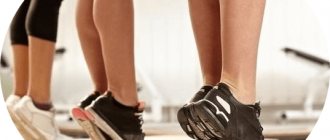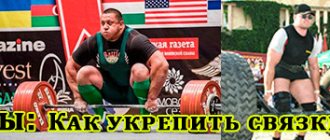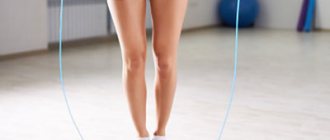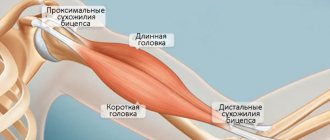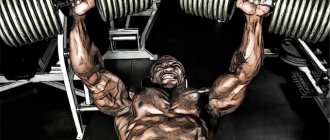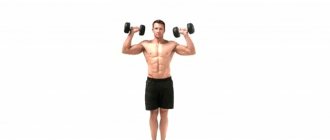Often, sprains in the groin area are observed during sports activities. And this is done as follows: during a sharp, strong acceleration, a sudden turn of the leg, a sharp change in direction, incorrect positioning of the leg, a fall, lymphadenitis in the groin, overstretching, the tendons and muscles located in the area of contact of the torso and hips are injured.
As a rule, it is the large triangular, long muscle, which is located on the inner side of the thigh, that is often damaged.
Symptoms of a sprained inguinal ligament
The main symptom of a sprained groin ligament is a kind of crunching sound in the hip area. After some time, swelling, swelling and pain may appear in the groin area. After about a day, a lump may appear in the area of the sprained inguinal ligament. After some time, namely after a day, a bruise and even greater swelling often appear. In this case, the long triangular muscle is not able to contract, and a depression, “bump,” etc. may appear on the injured leg.
Degrees of inguinal ligament stretching
Groin sprains are divided into three degrees based on the volume and intensity of damage:
1 The first degree is characterized by slight discomfort in the area of the injured leg, but the person is able to move.
2 The second degree of groin sprain is characterized by the same mild pain in the groin area, and the ability to perform some exercises is limited, such as running, long and high jumps, etc. In addition, swelling and bruising may occur.
3 The third degree of sprain of the inguinal ligaments implies severe pain while walking. Severe bruising and swelling often occur, and muscle spasms may occur.
Split stretching exercises
I offer you three great stretching exercises. These exercises are specifically aimed at the muscles that need to be stretched for the splits.
Stretching the groin muscles - rolls
This exercise stretches the buttocks and groin muscles. Develops balance and strengthens the back.
Stand straight, spread your feet about 1 meter wide. Then squat down on your right leg, keeping your left leg straight. The heel of the right foot is on the floor, the body is tilted forward, the hands rest on the floor, the toe of the left foot is pointed upward. Feel the stretch in your left hamstring, groin muscles, and right buttock. This is the starting position.
Smoothly move your body to the left, moving your hands along the floor, until you are in a completely symmetrical squat position on your left leg. In this case, the heel of the left foot should be on the floor, and the toe of the right foot should be pointed upward. Feel the stretch in the groin muscles, right hamstring, left buttock. Try to perform this roll as close to the floor as possible, without increasing the distance between the pelvis and the floor.
Then roll in the opposite direction. And thus perform at least 20-30 rolls, observing the technique and trying to stay as close to the floor as possible.
Split stretch - lunges with twists
The exercise stretches the buttocks, groin muscles and especially the hip flexors by rotating the torso.
Stand up straight. Take a deep lunge back with your left leg (or lunge forward with your right leg, whichever you prefer). Keep your left leg as straight as possible. Try to go as low as possible, feeling a stretch in your right buttock, left hip flexor and groin muscles. Place your hands on the knee of your right leg. Keep your torso upright or even tilt it back a little if you have enough flexibility. Stand like this for 5-15 seconds, trying to get as low as possible, keeping your left leg straight.
Then smoothly, helping yourself with your hands, turn your torso to the right as far as possible. At this point, try to feel an even greater stretch in your right glute and left hip flexor. Stay in this position for 5-15 seconds, trying to turn your torso even further and lower yourself a little lower.
Next, smoothly turn your torso to the left, while simultaneously turning your left foot with your toe to the left (the heel drops to the floor). You should get into a side lunge position. The foot of the right foot should not move (the heel is firmly on the floor). Try to go as low as possible in this new position, feeling the stretch in your groin muscles. Help yourself with your hands, balancing with them or holding the knee of your right leg. Stay in this position for 15-30 seconds. Then slowly return to the rear lunge position and stand.
Rest a little, and then perform the exercise for the second half of the body in exactly the same way. Maintain the same time intervals.
The exercise not only stretches the leg muscles well, but also significantly strengthens them. After such lunges, you may suddenly notice good tone in the muscles of the inner thighs. They may also increase slightly in size. The buttocks will also become noticeably rounder.
Stretching muscles using support
The exercise wonderfully stretches the hamstrings, buttocks, and groin area. Very strengthens the muscles of the legs, back and buttocks.
You will need a stable support with a height of 70 to 100 cm in height (other heights are possible depending on your flexibility). In the video I use a stack of steps.
Stand directly in front of the support at a distance of about 1 meter from it. Gently throw your left leg over it (you can use your hands). Adjust your position if it is not comfortable. Slightly bend your left leg at the knee according to safety precautions. The foot of the right supporting leg should be directed directly forward, as should the entire pelvic area. If you cannot direct your pelvis exactly forward, reduce the height of the support. The right leg itself should be straightened at the knee.
Keeping your back straight, gently bend forward towards your left leg. You can help yourself by grabbing the toe of this foot with your hands. Feel the stretch in your left thigh biceps and left glute. If you pull the toe towards you, you can also feel a stretch in the muscles of your left calf. Hold this stretched position for 5-15 seconds. Then straighten up smoothly.
Next, turn your body and toe of your right leg 90 degrees to the right, maintaining the position of your left leg. Feel the stretch in the groin area. Try to keep your entire body in the same plane. Wrap your left arm around your waist and lift your right arm up. Perform a side bend to your left leg lying on the support. Try not to leave the imaginary plane in which your body is located. Bend to the side, directly towards your leg. Let it not be big, but correct. Feel the stretch in your groin and left biceps. The stretch should also be felt in the waist. Hold this side bend for 5-15 seconds, then slowly straighten up.
Next, turn the foot of your left leg forward so that it rests on the support with its inner part. Cross your arms across your chest and bend toward your right leg, slightly bending it at the knee. Allow gravity to lower your body as low as possible. Remember to keep your back straight. Feel the stretch in the groin area, right hamstring, right buttock. Hold this bend for 5-15 seconds. Then, without helping yourself with your hands, straighten up, using only the strength of your buttocks and the biceps of your right thigh. After this, turn around to the original starting position and carefully lower your left leg to the floor.
Repeat the exercise with your right leg raised on a support.
* * *
We've learned three very powerful exercises for stretching your leg muscles. They will definitely help you do the splits if that is your goal.
Remember the rules for stretching and do not apply too much effort.
I wish you successful training!
Treatment of sprained inguinal ligaments
As with any injury such as a hamstring strain, you should immediately apply something cold to the injured area: ice, a frozen piece of meat, a handful of snow, a bottle of very cold water, etc. Then apply a tight bandage. The victim should not move in any way; he must be ensured complete rest. Sometimes crutches help. After providing first emergency aid, the victim should be immediately shown to a doctor. The fact is that a sprain in the groin can easily be confused with a fracture or dislocation, but here a completely different treatment is required.
The traumatologist will most likely advise you to strain the damaged area as little as possible in order to avoid worsening the situation, to exclude sports (only light jogging is possible), and heavy lifting. He will also most likely prescribe pain-relieving ointments, tablets, etc. In this case, plaster is not applied.
One of the proven folk remedies is turmeric powder. It should be mixed with a small amount of water to make “sour cream”, and then rub it on the sore spot.
Prevention
Pain in the inguinal ligaments can persist for up to 3-4 months. To avoid rupture of the inguinal ligaments and stretching of the back muscles, all movements must be done smoothly, without sudden twists. Before playing sports, you should “warm up” your muscles. These are, perhaps, the main points that should be followed to maintain the ligaments in a normal position.
During pregnancy, many women experience discomfort or pain in the groin area, which is most often associated with a sprained ligament.
In uncomplicated pregnancy, this condition is physiological and does not require correction. However, severe pain may indicate other causes of pathology that require referral to a specialist.
Treatment options for ankle sprains
Ankle sprains in most cases respond to conservative treatment methods. To relieve pain and prevent inflammation, drugs from the NSAID group are prescribed. To prevent the possibility of side effects, substances are used in soft dosage forms. Ointments show good results: Diclofenac, Artrosilene, Ibuprofen. Due to their pharmacological properties, the drugs reduce pain, improve blood circulation, and promote cell regeneration.
It is practiced to apply compresses with Dimexide to the pathological focus. The substance has analgesic, antimicrobial and anti-inflammatory potential. Due to its high bioavailability, the drug penetrates through the skin directly into the pathogenic cell. With its help, deep penetration of other pharmacological products is ensured.
For severe lesions, intramuscular administration of anti-inflammatory non-steroidal drugs and hormonal agents is used.
During the rehabilitation period, physiotherapeutic procedures are indicated.
Exercise therapy – at the initial stage, the complex consists only of light warm-up exercises. The main principle of the treatment is the absence of pain.
UHF – reduces swelling, accelerates the healing of damaged fibers.
Magnetic therapy – stimulates metabolic processes in the lesion.
Anatomy
The muscles of the anterior abdominal wall have an oblique course and are directed from top to bottom, ending in wide tendons called aponeuroses. These structures are woven into the bony formations of the pelvic bone, giving the walls of the abdominal cavity additional stability.
Location of the inguinal ligament
The inguinal (Pupart's) ligament is a continuation of the tendon part of one of the muscles of the anterior abdominal wall - the external oblique.
The ligament is attached to two bone formations: the pubic tubercle and the anterior superior iliac spine. Thus, this structure is located in a transverse-oblique direction between the two sections of the pelvis.
Inguinal canal
The direction of the ligament coincides with a hollow formation called the inguinal canal. In addition to the Poupartian one, other ligaments, aponeuroses, and muscle elements also participate in its formation.
In men, the spermatic cord passes through the canal, and in women, the round ligament of the uterus holds the organ in the pelvis.
The cavity also contains loose fiber and important vascular bundles that supply blood to the genitals.
What to do: first aid
Immediately after the incident, a person who has suffered a leg injury must urgently provide first aid, namely:
- Secure the injured limb with a tight bandage or an improvised splint, thereby providing it with the necessary fixation and rest;
- To reduce the likelihood of swelling and hematoma at the site of the sprain, you need to use ice or any other cold object. However, it should be remembered that cold can only be applied for the first few hours at intervals of 20-30 minutes, in order to avoid hypothermia;
- The use of gels and ointments that contain painkillers (diclofenac, ibuprofen and others) will help reduce inflammation. The action of these drugs is aimed at relieving pain symptoms and restoring ligaments.
Inguinal ligament sprain
Under the influence of a force that increases intra-abdominal pressure, stretching of the tendon elements of the inguinal ligament may occur, leading to symptoms. The cause of the pathology may be:
- Pregnancy. The amniotic sac that forms in the uterine cavity in late pregnancy can put pressure on the tendon elements of the pelvis. Hypovitaminosis and asthenic body type contribute to the pathology.
- Sports, industrial and domestic loads. Lifting weights causes the abdominal wall muscle fibers to contract and increases pressure on the Poupartian ligament, causing it to stretch.
- Lymphadenitis. Inflammation of the inguinal lymph nodes during infectious diseases can have a negative effect on the tendon structures.
- Systemic diseases of connective tissue, collagenosis contribute to dystrophic changes in the fibers of the ligament, and its anatomical integrity is disrupted.
Symptoms of a sprain
If the integrity of the fiber is damaged abruptly, at the moment of stretching the patient feels a crunching sensation and pain in the groin. During pregnancy, tension in the structure occurs gradually, without significant symptoms for a long time. Other signs:
- In the groin area, subcutaneous swelling of the tissues surrounding the ligament may form - a compensatory reaction of the body, which seeks to limit the source of damage.
- Pain in the groin on one or both sides increases, which increases when the torso is tilted or the lower limb is flexed at the hip joint.
- With palpation and pressure on the inguinal ligament, the pain intensifies, and subcutaneous tissue compaction may be detected.
A physiological condition during pregnancy is mild discomfort in the groin in late pregnancy. If symptoms are severe, you should consult a doctor who will conduct a comprehensive examination.
How to stretch to do the splits
Here are the basic exercises that will help warm up your muscles, work out your joints and bring you closer to the longitudinal splits.
Lunge
Slowly lower yourself into a deep lunge (another name for a runner). The front leg is bent at the knee at a right angle, the knee does not protrude beyond the big toe. The toe “looks” a little to the side, and the heel is turned forward. The back leg is straight and rests on the foot. Stretch your pelvis towards the floor. Hands can be on the floor, resting on the front knee, or raised up. Distribute your body weight evenly on both legs.
Knee Lunge
Staying in first position, move your hands inward toward your front leg and stand on your elbows. Place your back leg on the instep and knee, with your back straight. This exercise is aimed at stretching the inguinal ligaments and hip joints. Please note that both elbows should be at the same height. That is, if one hand stands on the elbow, and the other does not reach the floor, place bars for support. Lower your pelvis as low as possible. The variations of this exercise are endless: the back leg can be bent at the knee, the hands can rest on the pelvis, pushing it deeper.
Reaching for the leg
From a lunge, bend your back leg at a right angle and extend your front leg forward. Stretch your back straight towards your straight leg, place your elbows on the floor. You can make the exercise more difficult by bending your back leg and resting it against a wall or chair.
Pigeon
During this exercise, the pelvic bone covers the heel of the opposite leg. The position can be deepened by moving the leg forward, gradually opening the knee at a right angle. Place your hands on the knee of your front leg and try to twist your pelvis inward as much as possible. If you don't feel any tension, place your chest on your front calf to increase the pressure.
Pull your leg
This exercise will stretch the back of the thigh and work the hip joints. Lie on the floor on your back and lift your leg up. Pull it towards you with the opposite hand, both hands, or using a strap. The pelvis lies completely on the floor, the second leg is stretched as much as possible. Please note that the pelvis does not twist or change its position.
Diagnostics
To detect a sprain of the Poupart ligament, the doctor will carefully collect an anamnesis of the course of the disease, and then begin conducting diagnostic studies.
A general examination and palpation in the groin area on one or both sides is characterized by compaction or swelling of the subcutaneous tissue, reflex muscle spasm; a hernial protrusion may be detected in the openings of the inguinal canal with severe sprain of the ligament.
Ultrasound examination of the groin area will help to supplement and clarify the diagnosis.
Using ultrasound, you can check the integrity of the fibrous structures and the symmetry of the length of the ligaments on both sides. The technique allows you to detect an inguinal hernia, assess its condition, and the presence of complications.
Differential diagnosis
If during pregnancy there is a pulling in the groin area, the pain increases, and the ability to work at work and at home is impaired, it is necessary to ascertain the nature of the disease in order to begin treatment in a timely manner. In addition to a sprained inguinal ligament, the following conditions can cause symptoms:
- Hypertonicity of the uterus. This condition is characterized by increased excitability of the uterine muscles. The condition is dangerous for the fetus and the reproductive health of the mother and requires correction. Therapeutic and breathing exercises often help to cope with pathology.
- Pathology of nerve fibers. Increased abdominal pressure during pregnancy can put pressure on the sciatic nerve, which is located at the back of the pelvis. Characteristic is an increase in the intensity of symptoms when walking, irradiation of pain into the lower limb. After delivery, the condition goes away on its own.
- Symphysitis is a violation of the integrity of the pubic symphysis, the junction of the two pelvic bones. The pelvis can become unstable due to a lack of calcium, other trace elements and important vitamins. The condition manifests itself as severe pain when moving the legs away from the midline and is confirmed by ultrasound.
- Infections affecting the pelvic organs and regional (local) lymph nodes. Developing inflammatory and edematous syndromes can provoke pain in the groin area.
- Intestinal dyspepsia in the form of constipation syndrome. Under the influence of various mechanisms, including mechanical compression of the intestines by the growing uterus, constipation occurs. Increasing intra-abdominal pressure excites pain receptors in the pelvis and groin area.
- Varicose veins of the pelvis. A disease characterized by incompetence of the walls of venous vessels and the development of their dilations. Stagnation of blood causes pain and disruption of nutrition of surrounding tissues. The pathology requires complex treatment with the use of drugs that tonic the venous wall.
- Herpes infection is a severe viral disease that has a pathological effect on the life of the fetus. Infection of the genital organs causes pain in the groin, itching, and pathological discharge. Symptoms should be a reason to consult a doctor as soon as possible to prevent serious complications.
Basic treatment method
Sprains in the groin area are treated with medication. The doctor may prescribe the following group of drugs:
- Analgesics
- Anti-inflammatory drugs
- Hormonal medications
The last group is prescribed only as a last resort, when other drugs do not have the desired effect. Severe sprains that involve rupture of the ligament may require surgery. You can restore muscle function using ultrasound or laser.
During treatment, it is recommended to fix the mobility of the joint with a special bandage worn between the legs, or with a piece. You can also support and make the joint motionless using tape - a fabric adhesive tape that resembles a medical adhesive plaster.
Ointments for sprains
The best effect in treating tendon sprains in the groin are ointments that have a warming effect. But their long-term use by doctors is not recommended, as it can cause disorders in the gastrointestinal tract. The patient should remain calm while using medications.
This lasts on average from 4 to 6 days.
At the same time, you should not forget about applying cold every 3 hours.
No earlier than a week later, subject to improvement in well-being, rehabilitation physical training is allowed. But strictly after the doctor’s permission and very carefully.
You can practice at home or go to a clinic. The full duration of the course of treatment is individual in each case. The severity of the injury is of no small importance.
Taping for stretching
A popular method of auxiliary therapy for sprains is taping. Gluing the tape to the sore area allows the muscle to relax and at the same time supports it. This ensures the stability of the ligamentous apparatus. The procedure is carried out in compliance with certain rules:
- The skin must be prepared (cleaned and dried)
- The tape is applied without tension
- Its activation occurs by rubbing
By immobilizing the ligaments, the injury heals faster. Taping is also used during the rehabilitation period after surgery and for preventive purposes.
Treatment
Therapeutic measures depend on the degree of stretching of the fibrous elements, the presence of complications, and the stage of pregnancy. Often, when choosing a tactic, an obstetrician-gynecologist makes a decision together with a surgeon or traumatologist.
The general rules of treatment are changing lifestyle and creating functional rest. It is necessary to exclude physical activity that causes a sharp increase in intra-abdominal pressure.
Conservative treatment
With a low degree of stretching of the Pupart's ligament, calcium supplements, vitamin D, and a diet with a high content of dairy products are prescribed. Breathing exercises and special exercises for the abdominals are acceptable. The exercise therapy complex is compiled by a specialist and approved by the attending physician.
Treatment is complemented by physiotherapeutic procedures that relieve muscle spasms and increase blood flow to the pelvic organs.
Sometimes massage is used, which enhances and complements the effects of physiotherapy. The use of folk remedies is a controversial method of treatment. Any procedure must be agreed with the attending physician.
Surgery
A sprain of the inguinal ligaments, which led to the formation of an aponeurosis defect, requires surgical intervention. The hole is closed using special meshes from a mini-access on the anterior abdominal wall. The trauma and cosmetic defects of the operation are minimal, however, the indications for the operation are determined taking into account the duration of pregnancy and the condition of the fetus.
In cases of serious pathology, when a hernial protrusion protrudes through the damaged ligament, surgery is the only treatment. The hernia can become strangulated, causing disturbances in blood flow and severe complications for the intestines and other abdominal organs.
After consultation between the surgeon and an obstetrician-gynecologist, the timing of the herniotomy operation is selected.
Modern advances in surgery make it possible to close a hernia defect under local anesthesia with a minimal frequency of disease relapses. Symptoms of a sprained inguinal ligament should refer the patient to a specialist who will determine its nature at an early stage of the disease and provide appropriate treatment.
First aid
Most people with mild sprains can treat these injuries at home using:
- ice compresses (in the presence of hematoma and edema);
- immobilizing bandages (elastic bandages);
- over-the-counter painkillers (Ibuprofen, Diclofenac, Ketanova).
First aid for sprains - cold and rest
An ice pack is wrapped in a thin towel (to avoid cold injury) and applied to the injury site for 20 minutes every two hours for the first 24 hours after the sprain. If there is severe swelling, the injured limb should be kept elevated above the level of the heart, using pillows, chairs, and a blanket folded several times. This position improves venous outflow and prevents further growth of tissue around the joint.
In the first 72 hours after injury, it is advisable to apply cold to the sprained area. Ice will reduce acute inflammation and swelling. A warm compress is applied after a few days - it will ensure blood flow and speed up healing.
While the degree of pain and swelling are usually the best indicators of how serious a sprain or tear is, this is not always the case. Some injuries, such as an Achilles tendon injury, cause only minor pain at first but are actually quite serious. If symptoms worsen despite home treatment measures, and pain and swelling do not begin to improve within 24 to 72 hours after the injury, you should immediately consult a doctor for diagnosis and treatment.
Trying to stabilize the joint on your own can lead to worsening of the condition. Including a high risk of improper healing of an injury that has not been properly treated.
How to forget about joint pain?
- Joint pain limits your movements and full life...
- You are worried about discomfort, crunching and systematic pain...
- You may have tried a bunch of medications, creams and ointments...
- But judging by the fact that you are reading these lines, they did not help you much...
But orthopedist Sergei Bubnovsky claims that a truly effective remedy for joint pain exists!
In almost all cases, a sprained groin ligament is the result of mistakes when playing sports.
The groin area is a collection of plexuses of nerve fibers, blood vessels, and joints of the hip spine. In addition, it is in the groin area that the large thigh muscles and ligamentous tendon apparatus are located.
Most often, groin sprains occur in people with low to average levels of physical fitness. Such cases are common during sports, this is due to sudden acceleration in the exercise, incorrect rotation of the leg, change in direction of movement, falling and other errors.
Arm and back stretching
Forearm and shoulder stretch: Move one of your arms to the opposite side of your body. The correct thing to do is to try to press your hand as close to your body as possible and feel the tension. Hold the stretch for 10-15 seconds. Repeat on both sides five times.
Triceps stretch: Raise your bent arm with your elbow up and try to reach your shoulder blade with your palm.
You can stretch your triceps by moving your arms back.
Simple bends effectively stretch the entire spine, from the neck to the tailbone. Bend over without bending your knees and reach for your toes. Hold down for 10 seconds, rise up correctly and smoothly and perform the movement 5 times.
Perform the twist while sitting on the floor with your back straight. When making slow turns of the body in both directions, you need to monitor whether there is tension in the sides. When turning, the muscles of the abdomen, back and shoulders are involved. You can help yourself with your hands. Try to feel the pectoral muscles as well, actively expanding your chest. After the body is twisted in one direction, pause for 15-20 seconds, then take the starting position and turn in the other direction.
Exercise to stretch the lower back muscles: Sit on the floor and bring your legs together. Tilt your body, gently rounding your back. Keep your knees on the floor and grab your heels with your hands. Fixation for 30 seconds, then starting position.
The hamstring is a powerful anatomical formation that is a continuation of the muscles of the posterior thigh. Hamstring injuries are not uncommon, and one of the common causes of rupture or stretching of the hamstring fibers is improper stretching technique. Cycling and rowing are equally common causes of hamstring injuries.
Causes of sprained inguinal ligaments
Sprains are a common and far from pleasant injury. This process is painful and not as fast as we would like. That is why every person who is at risk should know the causes of sprained groin ligaments.
Typically, a sprain of the groin ligament is the result of a sudden movement in the joint that exceeds its usual amplitude. The main causes of traumatic injury are:
- gross mistakes and violations of rules in the gym,
- natural tendency to dislocations in the hip joint,
- arthritis and osteoarthritis of the hip joint,
- various inflammatory processes that can disrupt the functioning of the tendon apparatus.
Despite all the reasons for spraining the inguinal ligaments, it is worth noting that the regenerative ability of the ligamentous joints is quite high. A common example is the spontaneous fusion of ligaments even after they have been completely torn.
Symptoms
The most dangerous period when people receive certain injuries is winter, because it is with the onset of the first frost that the likelihood of falling, twisted legs and other similar injuries increases. Depending on the degree of sprain, the symptoms are as follows:
- With mild injuries to the ligaments in the leg, the patient feels discomfort and a slight nagging pain;
- The average degree is manifested by intense pain, bruising and swelling are present;
- With severe sprains, the pain is acute, pronounced, and dizziness and weakness are observed. Such injuries require immediate medical attention, as they may be accompanied by joint dysfunction.
Sprain in the groin area
A groin sprain is a process of injury to the various types of tendons and muscles that connect the torso and hip areas. Most often in such cases, the large triangular muscle, which is located on the inner side of the thigh, is damaged.
There are several degrees of inguinal ligament sprain:
- The first degree of injury is the mildest and is accompanied by minor discomfort in the area of the injured hip. In these cases, the traumatic injury does not hinder the person’s movement.
- The second degree is characterized by mild pain in the damaged area and limited ability to perform a number of exercises (jumping, running, swinging legs, etc.). In rare cases, bruising and swelling may occur.
- The third degree of severity is accompanied by severe pain when walking, as well as muscle spasms, swelling and bruising.
Prevention
Treatment and recovery after injuries and sprains of the inguinal ligaments can take a long time, it all depends on the degree of damage, as well as concomitant diseases. But, it is much easier to prevent damage to the ligaments; to do this, you should follow the following preventive rules:
- Before any activity, you should definitely do a warm-up.
- You need to include more activity in your passive lifestyle.
- Walk at least 10 thousand steps daily.
- Cycling and swimming in the pool 2-3 times a week.
- Proper nutrition, balanced diet.
- Cool down after strength training and stretching exercises.
- Timely treatment of injuries.
A sprained inguinal ligament is always accompanied by severe pain, fiber ruptures, and limitations in movement. The person feels discomfort and is deprived of the ability to fully actively move. In order to prevent the development of pathology, it is important to follow preventive measures to eliminate such injuries, providing a person with comfort and safety.
Share the article on social media. networks:
Symptoms of a sprained inguinal ligament
Symptoms of a sprained inguinal ligament depend on the form of the traumatic injury itself. There are three forms of injury: chronic, acute and subacute.
If we talk about the symptoms of chronic sprain of the inguinal ligaments, they will be different from the classic form. Such trauma often manifests itself with the onset of the formation of secondary pathologies. This process represents cicatricial changes in muscle and tendon tissue. This form of injury is observed in most cases in people who play sports professionally.
The acute form of injury is a complex of symptoms. First of all, it is acute pain in the area of injury. Sometimes the radius of pain can cover not only the inner part of the thigh, but also the outer one. Mobility in the area of traumatic injury becomes limited.
In the case of the subacute form, the symptoms are less noticeable, but still present. Low level of pain in the area of injury, mild swelling and slight limitation of hip mobility.
Symptoms
The most dangerous period when people receive certain injuries is winter, because it is with the onset of the first frost that the likelihood of falling, twisted legs and other similar injuries increases. Depending on the degree of sprain, the symptoms are as follows:
- With mild injuries to the ligaments in the leg, the patient feels discomfort and a slight nagging pain;
- The average degree is manifested by intense pain, bruising and swelling are present;
- With severe sprains, the pain is acute, pronounced, and dizziness and weakness are observed. Such injuries require immediate medical attention, as they may be accompanied by joint dysfunction.
Diagnosis of inguinal ligament sprain
When a sprained groin ligament is diagnosed, all the nuances of the injury are clarified. This process aims to recognize the damage and indicate its shape and complexity. In this way, a diagnosis is established, and further treatment measures are taken. Diagnosis is most often based on a general comprehensive study of the problem, a description of complaints and the use of necessary research. Establishing the correct diagnosis and determining the form of the sprain by a doctor is the key to a quick recovery from the injury.
The diagnosis is made by a traumatologist, who conducts an examination and decides on additional examination and the use of diagnostic equipment. For diagnosis, ultrasound, computed tomography and magnetic resonance imaging are used.
What to do: first aid
Immediately after the incident, a person who has suffered a leg injury must urgently provide first aid, namely:
- Secure the injured limb with a tight bandage or an improvised splint, thereby providing it with the necessary fixation and rest;
- To reduce the likelihood of swelling and hematoma at the site of the sprain, you need to use ice or any other cold object. However, it should be remembered that cold can only be applied for the first few hours at intervals of 20-30 minutes, in order to avoid hypothermia;
- The use of gels and ointments that contain painkillers (diclofenac, ibuprofen and others) will help reduce inflammation. The action of these drugs is aimed at relieving pain symptoms and restoring ligaments.
Treatment of inguinal sprains
A professional examination and an accurate diagnosis make it possible to begin treatment for a sprained inguinal ligament.
If you receive a sprained groin ligament, first aid must be provided. As with many cases of traumatic injury, something cold should be applied to the injured area of the hip. This could be ice, snow, a cold water bottle, or whatever you have on hand. After this, you must use a tight bandage. A person with such an injury is strongly advised to reduce movement as much as possible and ensure rest.
Once first aid has been provided, you need to make an appointment with a doctor. For recovery, it is usually recommended to reduce the load on the injury site in order to prevent the situation from worsening. The doctor will also prescribe ointments for external use and, if necessary, drug treatment.
Improper treatment of a sprained groin ligament can lead to undesirable consequences. Among them is an inguinal hernia, which may appear after some time. To avoid such troubles, you should always seek help from a qualified doctor and take all his recommendations responsibly.
Playing sports and attending various training sessions is prohibited until complete recovery and restoration of the ligamentous apparatus. The rehabilitation program may include attending physical therapy classes under the supervision of an instructor and therapeutic massage.
Hamstring exercises
You can check for yourself whether you have tight hamstrings. Lie on your back and stretch your legs. Then lift one leg as high as possible without bending your knees and keeping your lower back on the floor. The neck and shoulders should be relaxed. You need to raise your leg so that the toe is pointing towards the ceiling, but even an angle of 80° is quite normal. Anything less than this, as well as forced arching of the back and bent knees, indicate that you have tight hamstrings.
All three hamstring muscles—biceps, semitendinosus, and semimembranous—are attached to the ischial bones of the pelvis. The biceps femoris muscle is connected below to the head of the fibula. The semimembranous and semitendinosus muscles also pass through the knee joint and attach (one on top of the other) to the head of the tibia.
The muscles bend the leg at the knee and pull the heel towards the buttock. In addition, they straighten the hip (a movement that is especially important when climbing stairs) and help keep your back upright. The hamstring prevents you from falling forward while walking.
Compression of the hamstring often causes stress points to develop. So, the seat of a chair or car puts pressure on the back of the thigh, playing sports in which you have to run (football, basketball, rugby, etc.) - all this contributes to the appearance of stress points.
When stress points occur in the biceps femoris muscle, pain is felt at the back of the knee joint. When tension is present in the semitendinosus and semimembrane muscles, pain is felt in the lower buttocks and upper thighs. The pain may radiate down to the back of the thigh and ankle. When walking, the pain is so severe that it can lead to lameness. In a sitting position, discomfort also manifests itself - squeezing the hips with body weight increases the pain.
It's no surprise that stress points in the hamstring are often mistaken for sciatica. The hamstring muscles are very close to the quadriceps complex, so the stress points present in the former also affect the latter. This often results in pain in the front of the knees and hips. The pain does not go away until the tightness of the hamstring and quadriceps complex is released.
The attachment of the hamstring muscles can be felt while sitting on a chair - their upper ends are attached to the sit bones. If you place your hands under your buttocks, palms up, and then move back and forth, you can feel the movement of your sit bones. To feel the lower attachments of the hamstring, grab the right knee with your right hand on the outside and with your left on the inside so that your fingertips are in the depression behind the knee joint in the so-called popliteal space. In this position, you can feel the biceps tendon with your right hand and the semitendinosus tendon with your left hand. The semimembranous tendon runs under the semitendinosus muscle, so you won't be able to feel it.
You can work on stress points in the hamstring by sitting in a chair or table with your leg extended out to the side. Place a small, hard ball (such as a tennis ball) under your thigh in the softest spot (somewhere in the middle, but maybe a little to the right or left, depending on which muscle is affected). Compression will stretch tight bands of muscles and release tension points. Maintain this position until you are completely relaxed. Relax all points of tension. Stretching your muscles will also help you with this.
Stretch 1 can be done while sitting on the floor with your leg extended out to the side. You can do this with one leg or two legs at once. Without bending your knee, reach the base of your foot with your palm. Pull your thumb towards you (as shown in the picture). Maintain this position for 15-20 seconds.
Stretch 2: You can also stretch your muscles by placing your heel on a raised platform or on the seat of a chair. Make sure that the hip is not twisted and that the toes are pointed in one direction (as shown in the figure). Maintaining the angle between your thighs, lean forward slightly. If the position is performed correctly, you will feel a stretch. Maintain this position for 15-20 seconds. Repeat the stretch several times a day.
Once you have relieved the pain through self-medication, it is necessary to lengthen the hamstring with stretching to avoid the damage that shortened muscles can cause. You have to be patient and persistent - real stretching may take weeks and months, but it is worth the work and effort. Because the muscles that form the hamstring are very similar to the adductors, it is important to stretch them until they are completely relaxed. To do this, use stretching techniques for the adductors.
Train:
- Biceps hamstrings
- Semitendinosus muscle
- Semimembranosus muscle
Target:
- Hamstrings
Level:
- •For beginners
Advantages:
- Helps improve hamstring flexibility.
Contraindicated:
- For lower back problems
- For knee problems
1. In a standing position, bend one leg at the knee and extend the other in front of you, resting your heel on the floor.
2. Bend toward your extended leg, placing both hands above your knee. Place most of your weight on your front heel so that you feel the stretch in the muscles at the back of your thigh. Stay in this position for 30 seconds.
3. Switch legs and repeat the exercise. Do three 30-second sets on each leg.
Right:
- The leg should be extended.
- The toe of the leg extended forward should be taut as it stretches.
Wrong:
- The back should not bend or bend like a wheel.
- You should not slouch your shoulders. Published by econet.ru.
Did you like the article? Write your opinion in the comments. Subscribe to our FB:
Prevention of inguinal sprains
To protect yourself from injury, there is prevention of sprained inguinal ligaments. This is a simple complex that is aimed at reducing the risk of this injury.
First of all, before each session in the gym, jogging, or fitness, it is very important to stretch your muscles. A few simple exercises will help you warm up your muscles and prepare your body for physical activity. In addition, during the training process you need to pay attention to the smoothness of the movements performed. Every jerk, twist, or lift of your leg can increase your chances of suffering a groin sprain. By adhering to these simple rules, you can maintain the normal position of the ligamentous apparatus and get pure pleasure from the sport.
What exercises to do to do the splits
Comprehensive stretching exercises will significantly increase flexibility and, as a result, bring you closer to the transverse splits. We offer you basic exercises aimed at working out joints and warming up muscles and tendons:
Butterfly
The pose, which perfectly stretches the inner thigh, improves the flexibility of the inguinal ligaments. To perform this, you need to sit on the floor, bend your knees and bring your feet together, your heels pulled as close to your body as possible. At the same time, place your hands on your knees and squeeze them towards the floor. While doing this, watch your back; it should be as straight as possible. If your knees reach the floor and you do not experience any discomfort or slight pain, extend your arms forward and reach towards the floor.
Fold
Allows you to stretch the back and inner thighs, as well as the hamstrings. Sit on the floor and spread your legs as wide as possible. Twist your feet so that your toes point toward the ceiling, keeping your legs stretched. Extend your arms in front of you and begin to reach towards the floor. The chest and stomach should lie flat on the floor, the back should be as straight as possible. Maintain this position for five minutes, then alternately stretch to your right and left legs. Repeat the exercise several times.
Toad
The exercise stretches the inner thigh and inguinal ligaments. Lie on your stomach on the floor. Open your legs at right angles to your body and bend your knees. Shorten your feet so that your figure visually resembles the letter “P”. Hold the position for 5 minutes, and then begin to slowly bring your socks together. Your pelvis should lie completely on the floor. If you do not feel pain, then straighten your arms and bend your lower back.
We pull our socks to the floor
The exercise allows you to stretch the inner thigh, popliteal and inguinal ligaments. Lie on your back close to the wall. Raise your legs perpendicular to the floor, point your toes and pull your knees. Slowly spread your legs, pointing your toes to the floor. For greater effectiveness, you can wear weights on your legs. Stay in this position for seven to ten minutes. After finishing, slowly bring your legs together without sudden movements.
We reach our elbows to the floor
A very useful and important exercise. It is recommended to perform immediately before the twine. From a standing position, place your feet shoulder-width apart. Leaning forward, try to reach your elbows to the floor. The back should remain as straight as possible. After this, stretch alternately to your right and left legs. Repeat the movement several times, freezing in each position for one minute.
Prognosis of inguinal ligament sprain
Ligaments are important components of connective tissue and perform the function of connecting bones in joints to each other. It is the ligamentous apparatus that ensures the mobility of the joints and their correct movement. They also restrict joints from moving in directions that are unusual for them.
Let's make a small forecast for a sprained inguinal ligament. If you reduce ignorance of the rules of warming up and warming up your muscles before training, the incidence of injuries will become much less. Beginners in sports need to objectively look at the tasks they have set for themselves and not expect quick results. It is the manifestation of intolerance in sports that is a harbinger of injuries and exclusion from training for a long time.
A sprained groin ligament is one of the most common injuries in people involved in sports. The more experience an athlete has, the less chance he has of making such mistakes.
A sprained groin ligament is an extremely unpleasant thing. The main reasons are overstrain in the groin, which occurs after training. An athlete or person who plays sports may suddenly accelerate, accidentally turn their leg the wrong way, or fall.
As a result, both muscles and tendons are injured in the groin area. How to treat such an unpleasant disease?
Types of sprains
The goal of treating a groin strain is to repair the ligaments. They should become elastic again, and the walls of the inguinal canal should be intact. There are different types of groin sprains, as well as methods of their treatment:
Inguinal hernia
1. Incomplete sprain and rupture of ligaments in the groin. Doctors usually recommend rest in this case. Sometimes treatment is accompanied by physiotherapy and special physical exercises under the supervision of a traumatologist. 2. Sprain of the inguinal ligaments, in which most of the fibers are damaged. In this case, the intervention of a surgeon is already required to restore the integrity of the ligaments. 3. Inguinal hernia. It is considered the most dangerous, because often accompanied by infringement. Its occurrence can be prevented if you go to the clinic in time after experiencing pain.
Onset of the disease
Determining whether an athlete has pulled ligaments in the groin is quite simple. Typically the picture of the disease looks like this:
- a person feels a crunch in the thigh area;
- swelling and cramps appear;
- the groin muscle hurts and swells;
- a bruise appears in the groin area.
The person first experiences pain in the groin. A day later, a lump appears in the place where the muscle is stretched. Blood vessels in the groin rupture. A bruise appears. These are only external signs of stretching. There are also internal ones. Doctors say that when the groin muscles are stretched and blood vessels rupture, the processes that occur in the tissues are destructive. The fact is that when the vessels lose their own integrity, swelling appears. The stretch is accompanied by weakening of the groin muscle. Therefore, cramps are a consequence of the fact that muscle strength has weakened. In addition, the disease limits a person’s movement. It becomes difficult to walk and bend over. A sprain, as traumatologists say, requires immediate treatment. Otherwise, the person will completely lose the ability to move.
A sprain in the groin area is accompanied by a strange sound, similar to a crunch. A person may not immediately notice the primary symptoms of the disease. Sometimes a bruise at the site of the sprain does not appear immediately, but after a few days. A bump doesn't always appear. Sometimes a depression forms in its place.
How to treat a sprain: conservative, surgical and home methods
Before determining treatment tactics, the traumatologist must exclude concomitant complications (dislocations, fractures) and determine the degree of injury. To do this, X-ray diagnostics, CT or MRI of the ankle are performed, which allow us to assess the condition of the joint.
In most cases, conservative treatment is sufficient to fully restore motor activity. With a mild sprain of the foot, the patient is advised to rest as much as possible until the pain is relieved, and physiotherapy and exercise therapy are recommended immediately after recovery. If necessary, painkillers and anti-inflammatory ointments can be applied to the injured area.
For moderate sprains, in addition to the basic course, it is recommended to take painkillers and anti-inflammatory drugs that will relieve unpleasant symptoms. In this case, a soft “figure eight” bandage is applied to the ankle.
The third, most severe degree of sprain, requires a much more serious approach. Treating it at home is a futile task, since the patient requires regular physiotherapeutic procedures and injections of anti-inflammatory pharmaceuticals. To immobilize the foot with such severe damage, not a bandage, but a plaster cast is used.
Physiotherapeutic treatment
Physiotherapy is an extremely effective and completely safe way to restore foot mobility after a sprain. Properly selected procedures trigger tissue regeneration processes, improve blood flow, and relieve pain and inflammation.
Physical therapy usually begins 2-3 days after the sprain. The most effective methods that have proven themselves in combating the consequences of injuries include:
- Electrical neurostimulation – relieves pain, eliminates limited mobility and low functionality.
- Diadynamic therapy - activates metabolic mechanisms, thereby improving the processes of restoration of ligamentous fibers.
- Laser therapy – promotes better lymph drainage, relieves swelling and inflammation.
- Cryotherapy – has anti-inflammatory and analgesic effects.
- Amplipulse therapy - stimulates muscle activity, increases the elasticity of ligaments and accelerates recovery.
Surgery
Surgical treatment is only required if the ligaments are completely torn. If the injury is this severe, the surgeon will need to make an incision in the soft tissue of the foot and manually connect the torn fibers. As a rule, such an operation requires long-term rehabilitation (10 weeks or more) and does not always result in complete restoration of the range of motion in the ankle.
Folk remedies for sprains
In parallel with conservative treatment, you can try to speed up recovery using traditional medicine methods:
- Potato compresses. The finely grated tuber should be mixed with chopped onions and a tablespoon of sugar, wrapped in a gauze bag and applied to the sore foot.
- Garlic-lemon lotions. Chopped garlic cloves (2-3 pieces) should be poured with warm water, allowed to brew for an hour, then diluted with the juice of 1 lemon. Soak a napkin in the resulting liquid and apply it to the affected leg for 1-2 hours.
Competent consultation with a specialist and comprehensive treatment will allow you to quickly restore foot mobility after a sprain and avoid recurrence of a painful injury!
I like 1
Sprain Sprain Ankle Sprain Foot Injury Leg Injury Ligaments Sprain Treatment Injury Treatment
Related Posts
leave a comment
Only 4 comments.
Marina
with us 2 years, 9 months, 22 days
2020-01-21 10:17:17I twisted my ankle and immediately put on a fixing bandage. I went to the doctor for a sprain. Physiotherapy treatment, rubbing rheumalgon with Twins Tech gel. Contains chondroitin and it helps restore the cartilaginous surfaces of the joints and spine, reduces degenerative changes in the joints, improves their mobility, and stimulates the regeneration of cartilage tissue.
Violet
with us 11 months, 24 days
2019-11-04 10:10:13We recently hosted a volleyball competition in our city. In the gym of the physical education center. I was so nervous before the game, I was afraid that something would go wrong. In the end, this is what happened, in the middle of the game I fell hard, injured my leg, but continued to play. After the game I barely made it home. My leg hurt terribly, and already at home I saw that I had a bruise. My husband began to smear this place with balm for this. The balm has a very strange name: toad stone. The balm itself turned out to be very effective, it helped, after a few days the leg gradually began to improve and went away.
Andrey
with us 1 year, 1 month, 20 days
2019-08-19 00:18:51I jumped from a tower into the water, upon arriving home 1.5 hours later I felt incredible pain, I went to the trauma center - they took a picture and said there was no fracture, but it was a sprain. They prescribed cold and fastum gel for tomorrow. I would never have thought that such pain could be caused by a sprain; I can hardly squeeze the clutch in the car! I'll apply a bandage.
First aid
Often timely and correctly provided first aid allows you to avoid surgical intervention. Rapid relief of inflammatory swelling prevents injury to soft tissues, compression of nerve endings, and damage to small blood vessels.
| Stages of first aid to the victim | Correct provision of first aid |
| Immobilization | The victim should be placed on a hard surface, with the leg raised so that the foot is slightly higher than the chest. To do this, place a bolster or pillow under your ankle. |
| Joint fixation | To immobilize the foot, it is necessary to make a splint from available materials. If you don’t have the skills, you can fix your leg up to the knee with an elastic bandage or a special compression bandage |
| Cold compresses | Immediately after injuring the ligaments, cold should be applied to the foot: apply a plastic bag with ice cubes, wrapped in thick cloth, for 10 minutes. The procedure must be repeated every hour. If there is no ice, then a piece of frozen meat or a bag of mixed vegetables will do. |
| Taking medications | To eliminate pain, it is necessary to give the victim a non-steroidal anti-inflammatory drug (NSAID) tablet, for example, Nise, Ketorol, Diclofenac |
Splint for fixing the foot and ankle.
